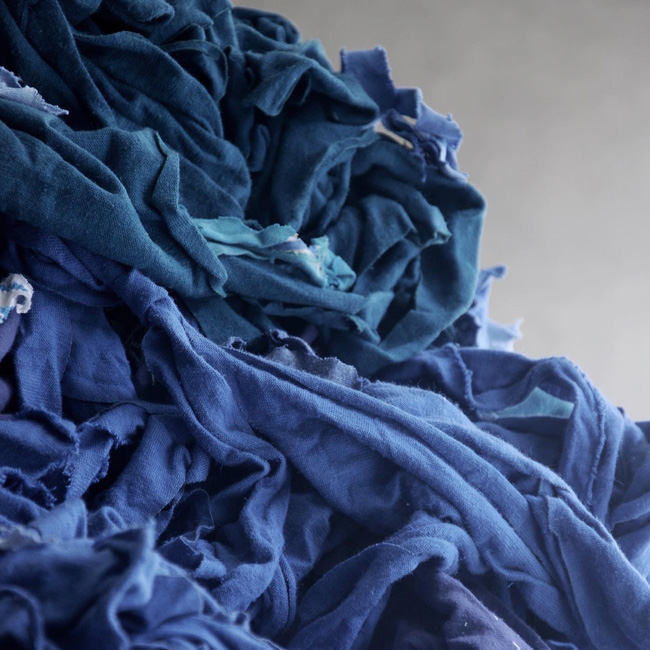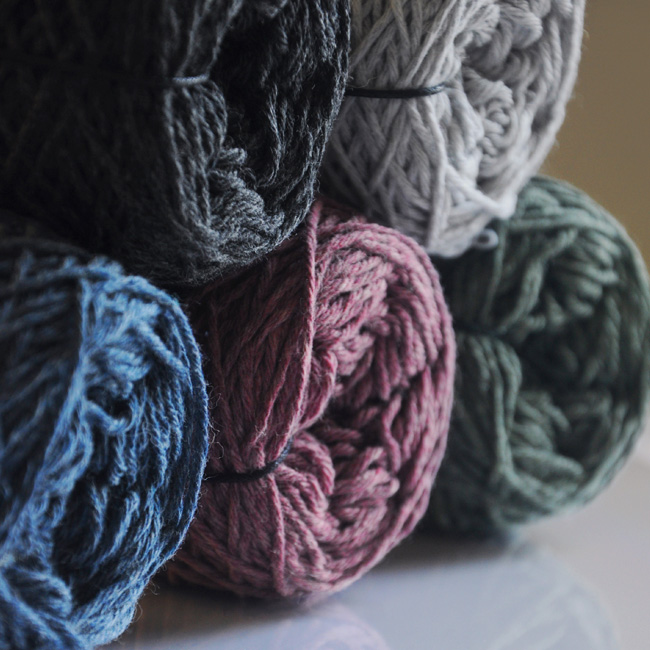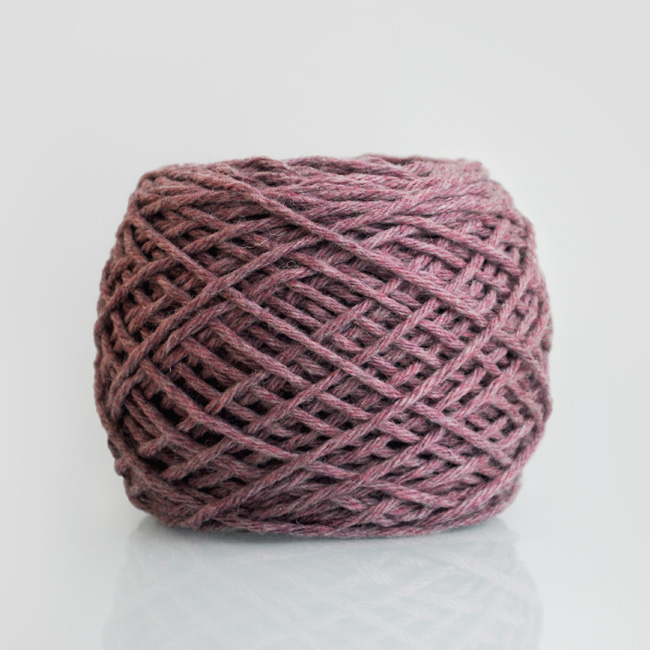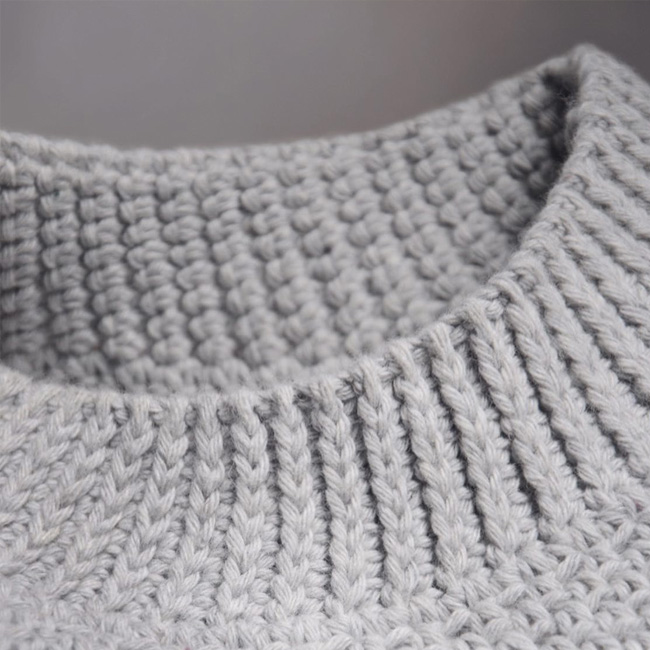Recycling Waste into Yarn:
Interview with Guy Dempster
Get to know Dempstah’s co-founder Guy Dempster, whose Australia-based company recycles textile waste into knitting yarn
Tell us about Dempstah
Dempstah is recycling Australian textile waste into spun yarn, in collaboration with The Billie System and Novetex Textiles.
We source both pre and post–consumer textile waste from donors in and around Sydney– including offcuts from fashion labels who manufacture locally, unsellable second hand items from charity stores and public collection campaigns. We then sort and send these recyclables to The Billie to undergo fibre recovery, and then on to Novetex’s Zhuhai mill to be blended and spun into yarn.
We currently sell our recycled yarns through several stockists in Sydney, Melbourne, regional NSW and Tasmania– and are now using them to develop our own range of knitwear and knitted homewares.
In your view, what are the challenges faced by the fashion industry?
I believe the primary challenge is that our current way of life is causing ecological destabilisation on a global scale; from fossil fuel–induced climate change and the mass dumping of waste, to deforestation and biodiversity loss. We’re coming to terms with the fact that so many of our modern production and consumption practices are at odds with the fragile and finite nature of our planet.
When it comes to the fashion industry and the challenges we face on this front, I often think back to something my previous manager said to me while I was working at Novetex Textiles:
‘Businesses are like ships. Big ships can travel very far and have enormous cargo carrying capacities, but their size makes them extremely slow to turn in order to avoid obstacles in their path. Small ships may travel shorter distances and carry less cargo, but they’re agile and can easily pivot and change course when required.’ We’re certainly seeing this metaphor in action amongst the fashion industry players we’ve encountered.
Big businesses can appear fixated on measuring their success using traditional metrics of profitability and expansion alone, and often seem to believe that any deviation from their current trajectory will threaten their survival (despite this approach incentivising some seriously unhealthy manufacturing and consumption practices).
We’ve repeatedly encountered a sentiment of ‘yes we’re super into sustainability and circularity– provided we don’t have to change anything about how we operate, and avoid any and all disruptions to business as usual’.
It’s the smaller businesses we work with, on the other hand, that seem to be actively seeking solutions to alleviate their environmental impact. There’s a level of flexibility, an eagerness to experiment and implement, and a general values–alignment there that gives us a lot of hope.
I guess the challenge is how we get the biggest ships to turn as swiftly as possible, before they sink us all!
If you could solve one environmental sustainability-related issue in our industry, what would it be?
I would love to see a massive reduction in the use of cheap, petroleum–derived synthetic fibre in our textile goods, in favour of natural and recycled fibre.
A while ago I drafted an infographic about how synthetic fibres like Polyester and Acrylic were made– from their material origins through to the final textile.
I read through encyclopaedia Britannica articles on the chemical processes involved, and even posted a few questions in some chemistry and material engineering forums online to clarify my understanding.
It took all of that for the realisation to really sink in, that both climate change and the waste crisis– two of the greatest threats to the health of our environment– were essentially one in the same.
Whether it’s the greenhouse gases distorting our climate, the rigid plastics floating in our oceans or the synthetic textiles being ground down to microfibre in our landfills, they’re all derived from the same thing: fossil fuels. Fracked, mined and drilled.
Some Australian states are now regulating the use of various types of single–use plastics and plastic packaging to reduce waste across the hospitality and retail industries, and I often find myself fantasising about similar restrictions on the use of petroleum–based fibres in our textiles products (products which so many consumers now treat as disposable too).
Cheap, synthetic materials are the backbone of fast fashion. Without them, this tier of the industry would struggle to achieve such perversely low pricing for its products.
Pushing the industry towards the use of natural or recycled fibre alternatives may cause a corrective increase in the price of our clothing– but this would likely cause us to attach greater value to the textile products we own, helping to curb the throwaway culture exacerbated by fast fashion and reduce the amount of textile waste being discarded in our communities.
As the world transitions away from fossil fuels as an energy source and we stop extracting all this stuff, I’m interested to see if this will affect the price of synthetic textiles. It takes enormous industrial effort and ingenuity to extract all these resources and turn them into fabrics– such materials are only as cheap as they are now because the producers have achieved dramatic economies of scale.
Why is sustainability important to you (and your brand)? What are your current goals?
Dempstah’s core, ongoing goal is to recycle Australian textile waste into new textile products; showcasing the types of materials and applications the practice can yield, and building a strong brand around our commitment to creating products according to the principles of circular design.
We’re keen to develop ourselves into a Social Enterprise Business, which would mean we measure our success not just by sales revenue or net profit, but by the qualitative impact our activity is having on a particular social or environmental issue– which for us would be intercepting and diverting recyclable textiles before they end up in local or foreign landfill, and giving them a second life as new textile products.
What about your long-term priorities as a company?
Long-term, our priority would be to slowly start clawing back some aspects of the manufacturing process in the hopes of establishing our own local micro–mill. We could start by procuring our own industrial knitwear machinery, enabling us to manufacture readymade products from our recycled yarns here in Sydney. Then, with The Billie’s assistance, even licence and procure certain key pieces of machinery which comprise the fibre recovery system they’ve originated (e.g. Ozone sanitisation and optical colour sortation machines).
When my partner Otis Ng and I first toured The Billie System in Tai Po in mid-2019, one of the things that struck us was the ingenious lengths the team had gone to in order to make the fibre recovery process as resource–lite as possible. Given how traditionally resource–intensive and potentially toxic textile manufacturing can be, the complete elimination of all water, bleach, detergent, dye, mordant and any chemical waste from the fibre recovery process was and is completely unprecedented across industry. The ability to cultivate new fibre for textile production without the use of any water could prove especially pertinent to Australia, where we suffer ever–worsening droughts, and water scarcity issues plague regional communities and agricultural operations.
Over the past two years as we’ve learnt more about The Billie System– guided always by the expertise of The Billie’s team of highly skilled technicians– I’ve become more aware than ever of the sad lack of equivalent expertise here in Australia.
While Australia may be the source of some of the highest quality virgin merino wool and cotton fibre in the world, we suffer an immense dearth of spinning and fibre processing facilities– activities which are almost universally outsourced overseas.
To reclaim even just a part of the textile manufacturing process, and in doing so garner the relevant technical expertise required to administer it (and innovate)– even at a boutique scale– would be a boon for both us as a company and our community.
What were your thoughts on your collaboration with The Billie System? How did this partnership benefit your company or advance your objectives?
I’ve often described my work with The Billie System as akin to receiving a Master’s Degree in Textile Fibre Recovery.
The insight I’ve garnered into this unique industrial practice over the past two years of our relationship has been invaluable. From a place of deep cynicism towards our industry I have felt myself growing ever more hopeful that an alignment of circular values, technological innovation and human ingenuity can yield real results– offering a glimpse of what the future of our industry could look like.
We’re currently working with The Billie System on an upcoming consignment of textile waste, comprised of post–consumer knitwear supplied by the Salvation Army (Salvos) charity store depot in Sydney’s Inner West. All items were originally donated to Salvos by the general public, but deemed unsellable due to issues with their condition (torn seams, holes, rips, discolouration and stains), despite often being composed of quality, natural fibre content.
To fund the project we’ve received an Environmental Performance Innovation Grant from The City of Sydney, under their Waste Management category. It’s an immensely exciting project for us as we discover what kind of textile we can transform these recyclable items into, but I believe also for The Billie team– who have are keen to test the limits of their system when working with such a diverse spectrum of post–consumer textile waste.
The willingness of The Billie team to collaborate and educate us, despite the nascency of our operation, is something we’re immensely grateful for.





Recycling Waste into Yarn: Interview with Guy Dempster
Get to know Dempstah’s co-founder Guy Dempster, whose Australia-based company recycles textile waste into knitting yarn
Tell us about Dempstah.
Dempstah is recycling Australian textile waste into spun yarn, in collaboration with The Billie System and Novetex Textiles.
We source both pre and post–consumer textile waste from donors in and around Sydney– including offcuts from fashion labels who manufacture locally, unsellable second hand items from charity stores and public collection campaigns. We then sort and send these recyclables to The Billie to undergo fibre recovery, and then on to Novetex’s Zhuhai mill to be blended and spun into yarn.
We currently sell our recycled yarns through several stockists in Sydney, Melbourne, regional NSW and Tasmania– and are now using them to develop our own range of knitwear and knitted homewares.
In your view, what are the challenges faced by the fashion industry?
I believe the primary challenge is that our current way of life is causing ecological destabilisation on a global scale; from fossil fuel–induced climate change and the mass dumping of waste, to deforestation and biodiversity loss. We’re coming to terms with the fact that so many of our modern production and consumption practices are at odds with the fragile and finite nature of our planet.
When it comes to the fashion industry and the challenges we face on this front, I often think back to something my previous manager said to me while I was working at Novetex Textiles:
‘Businesses are like ships. Big ships can travel very far and have enormous cargo carrying capacities, but their size makes them extremely slow to turn in order to avoid obstacles in their path. Small ships may travel shorter distances and carry less cargo, but they’re agile and can easily pivot and change course when required.’ We’re certainly seeing this metaphor in action amongst the fashion industry players we’ve encountered.
Big businesses can appear fixated on measuring their success using traditional metrics of profitability and expansion alone, and often seem to believe that any deviation from their current trajectory will threaten their survival (despite this approach incentivising some seriously unhealthy manufacturing and consumption practices).
We’ve repeatedly encountered a sentiment of ‘yes we’re super into sustainability and circularity– provided we don’t have to change anything about how we operate, and avoid any and all disruptions to business as usual’.
It’s the smaller businesses we work with, on the other hand, that seem to be actively seeking solutions to alleviate their environmental impact. There’s a level of flexibility, an eagerness to experiment and implement, and a general values–alignment there that gives us a lot of hope.
I guess the challenge is how we get the biggest ships to turn as swiftly as possible, before they sink us all!





If you could solve one environmental sustainability-related issue in our industry, what would it be?
I would love to see a massive reduction in the use of cheap, petroleum–derived synthetic fibre in our textile goods, in favour of natural and recycled fibre.
A while ago I drafted an infographic about how synthetic fibres like Polyester and Acrylic were made– from their material origins through to the final textile.
I read through encyclopaedia Britannica articles on the chemical processes involved, and even posted a few questions in some chemistry and material engineering forums online to clarify my understanding.
It took all of that for the realisation to really sink in, that both climate change and the waste crisis– two of the greatest threats to the health of our environment– were essentially one in the same.
Whether it’s the greenhouse gases distorting our climate, the rigid plastics floating in our oceans or the synthetic textiles being ground down to microfibre in our landfills, they’re all derived from the same thing: fossil fuels. Fracked, mined and drilled.
Some Australian states are now regulating the use of various types of single–use plastics and plastic packaging to reduce waste across the hospitality and retail industries, and I often find myself fantasising about similar restrictions on the use of petroleum–based fibres in our textiles products (products which so many consumers now treat as disposable too).
Cheap, synthetic materials are the backbone of fast fashion. Without them, this tier of the industry would struggle to achieve such perversely low pricing for its products.
Pushing the industry towards the use of natural or recycled fibre alternatives may cause a corrective increase in the price of our clothing– but this would likely cause us to attach greater value to the textile products we own, helping to curb the throwaway culture exacerbated by fast fashion and reduce the amount of textile waste being discarded in our communities.
As the world transitions away from fossil fuels as an energy source and we stop extracting all this stuff, I’m interested to see if this will affect the price of synthetic textiles. It takes enormous industrial effort and ingenuity to extract all these resources and turn them into fabrics– such materials are only as cheap as they are now because the producers have achieved dramatic economies of scale.
Why is sustainability important to you (and your brand)? What are your current goals?
Dempstah’s core, ongoing goal is to recycle Australian textile waste into new textile products; showcasing the types of materials and applications the practice can yield, and building a strong brand around our commitment to creating products according to the principles of circular design.
We’re keen to develop ourselves into a Social Enterprise Business, which would mean we measure our success not just by sales revenue or net profit, but by the qualitative impact our activity is having on a particular social or environmental issue– which for us would be intercepting and diverting recyclable textiles before they end up in local or foreign landfill, and giving them a second life as new textile products.
What about your long-term priorities as a company?
Long-term, our priority would be to slowly start clawing back some aspects of the manufacturing process in the hopes of establishing our own local micro–mill. We could start by procuring our own industrial knitwear machinery, enabling us to manufacture readymade products from our recycled yarns here in Sydney. Then, with The Billie’s assistance, even licence and procure certain key pieces of machinery which comprise the fibre recovery system they’ve originated (e.g. Ozone sanitisation and optical colour sortation machines).
When my partner Otis Ng and I first toured The Billie System in Tai Po in mid-2019, one of the things that struck us was the ingenious lengths the team had gone to in order to make the fibre recovery process as resource–lite as possible. Given how traditionally resource–intensive and potentially toxic textile manufacturing can be, the complete elimination of all water, bleach, detergent, dye, mordant and any chemical waste from the fibre recovery process was and is completely unprecedented across industry. The ability to cultivate new fibre for textile production without the use of any water could prove especially pertinent to Australia, where we suffer ever–worsening droughts, and water scarcity issues plague regional communities and agricultural operations.
Over the past two years as we’ve learnt more about The Billie System– guided always by the expertise of The Billie’s team of highly skilled technicians– I’ve become more aware than ever of the sad lack of equivalent expertise here in Australia.
While Australia may be the source of some of the highest quality virgin merino wool and cotton fibre in the world, we suffer an immense dearth of spinning and fibre processing facilities– activities which are almost universally outsourced overseas.
To reclaim even just a part of the textile manufacturing process, and in doing so garner the relevant technical expertise required to administer it (and innovate)– even at a boutique scale– would be a boon for both us as a company and our community.
What were your thoughts on your collaboration with The Billie System? How did this partnership benefit your company or advance your objectives?
I’ve often described my work with The Billie System as akin to receiving a Master’s Degree in Textile Fibre Recovery.
The insight I’ve garnered into this unique industrial practice over the past two years of our relationship has been invaluable. From a place of deep cynicism towards our industry I have felt myself growing ever more hopeful that an alignment of circular values, technological innovation and human ingenuity can yield real results– offering a glimpse of what the future of our industry could look like.
We’re currently working with The Billie System on an upcoming consignment of textile waste, comprised of post–consumer knitwear supplied by the Salvation Army (Salvos) charity store depot in Sydney’s Inner West. All items were originally donated to Salvos by the general public, but deemed unsellable due to issues with their condition (torn seams, holes, rips, discolouration and stains), despite often being composed of quality, natural fibre content.
To fund the project we’ve received an Environmental Performance Innovation Grant from The City of Sydney, under their Waste Management category. It’s an immensely exciting project for us as we discover what kind of textile we can transform these recyclable items into, but I believe also for The Billie team– who have are keen to test the limits of their system when working with such a diverse spectrum of post–consumer textile waste.
The willingness of The Billie team to collaborate and educate us, despite the nascency of our operation, is something we’re immensely grateful for.
Recycling Waste
into Yarn:
Interview with
Guy Dempster
Get to know Dempstah’s co-founder Guy Dempster, whose Australia-based company recycles textile waste into knitting yarn

Tell us about Dempstah
Dempstah is recycling Australian textile waste into spun yarn, in collaboration with The Billie System and Novetex Textiles.
We source both pre and post–consumer textile waste from donors in and around Sydney– including offcuts from fashion labels who manufacture locally, unsellable second hand items from charity stores and public collection campaigns. We then sort and send these recyclables to The Billie to undergo fibre recovery, and then on to Novetex’s Zhuhai mill to be blended and spun into yarn.
We currently sell our recycled yarns through several stockists in Sydney, Melbourne, regional NSW and Tasmania– and are now using them to develop our own range of knitwear and knitted homewares.

In your view, what are the challenges faced by the fashion industry?
I believe the primary challenge is that our current way of life is causing ecological destabilisation on a global scale; from fossil fuel–induced climate change and the mass dumping of waste, to deforestation and biodiversity loss. We’re coming to terms with the fact that so many of our modern production and consumption practices are at odds with the fragile and finite nature of our planet.
When it comes to the fashion industry and the challenges we face on this front, I often think back to something my previous manager said to me while I was working at Novetex Textiles:
‘Businesses are like ships. Big ships can travel very far and have enormous cargo carrying capacities, but their size makes them extremely slow to turn in order to avoid obstacles in their path. Small ships may travel shorter distances and carry less cargo, but they’re agile and can easily pivot and change course when required.’ We’re certainly seeing this metaphor in action amongst the fashion industry players we’ve encountered.
Big businesses can appear fixated on measuring their success using traditional metrics of profitability and expansion alone, and often seem to believe that any deviation from their current trajectory will threaten their survival (despite this approach incentivising some seriously unhealthy manufacturing and consumption practices).
We’ve repeatedly encountered a sentiment of ‘yes we’re super into sustainability and circularity– provided we don’t have to change anything about how we operate, and avoid any and all disruptions to business as usual’.
It’s the smaller businesses we work with, on the other hand, that seem to be actively seeking solutions to alleviate their environmental impact. There’s a level of flexibility, an eagerness to experiment and implement, and a general values–alignment there that gives us a lot of hope.
I guess the challenge is how we get the biggest ships to turn as swiftly as possible, before they sink us all!

If you could solve one environmental sustainability-related issue in our industry, what would it be?
I would love to see a massive reduction in the use of cheap, petroleum–derived synthetic fibre in our textile goods, in favour of natural and recycled fibre.
A while ago I drafted an infographic about how synthetic fibres like Polyester and Acrylic were made– from their material origins through to the final textile.
I read through encyclopaedia Britannica articles on the chemical processes involved, and even posted a few questions in some chemistry and material engineering forums online to clarify my understanding.
It took all of that for the realisation to really sink in, that both climate change and the waste crisis– two of the greatest threats to the health of our environment– were essentially one in the same.
Whether it’s the greenhouse gases distorting our climate, the rigid plastics floating in our oceans or the synthetic textiles being ground down to microfibre in our landfills, they’re all derived from the same thing: fossil fuels. Fracked, mined and drilled.
Some Australian states are now regulating the use of various types of single–use plastics and plastic packaging to reduce waste across the hospitality and retail industries, and I often find myself fantasising about similar restrictions on the use of petroleum–based fibres in our textiles products (products which so many consumers now treat as disposable too).
Cheap, synthetic materials are the backbone of fast fashion. Without them, this tier of the industry would struggle to achieve such perversely low pricing for its products.
Pushing the industry towards the use of natural or recycled fibre alternatives may cause a corrective increase in the price of our clothing– but this would likely cause us to attach greater value to the textile products we own, helping to curb the throwaway culture exacerbated by fast fashion and reduce the amount of textile waste being discarded in our communities.
As the world transitions away from fossil fuels as an energy source and we stop extracting all this stuff, I’m interested to see if this will affect the price of synthetic textiles. It takes enormous industrial effort and ingenuity to extract all these resources and turn them into fabrics– such materials are only as cheap as they are now because the producers have achieved dramatic economies of scale.

Why is sustainability important to you (and your brand)? What are your current goals?
Dempstah’s core, ongoing goal is to recycle Australian textile waste into new textile products; showcasing the types of materials and applications the practice can yield, and building a strong brand around our commitment to creating products according to the principles of circular design.
We’re keen to develop ourselves into a Social Enterprise Business, which would mean we measure our success not just by sales revenue or net profit, but by the qualitative impact our activity is having on a particular social or environmental issue– which for us would be intercepting and diverting recyclable textiles before they end up in local or foreign landfill, and giving them a second life as new textile products.

What about your long-term priorities as a company?
Long-term, our priority would be to slowly start clawing back some aspects of the manufacturing process in the hopes of establishing our own local micro–mill. We could start by procuring our own industrial knitwear machinery, enabling us to manufacture readymade products from our recycled yarns here in Sydney. Then, with The Billie’s assistance, even licence and procure certain key pieces of machinery which comprise the fibre recovery system they’ve originated (e.g. Ozone sanitisation and optical colour sortation machines).
When my partner Otis Ng and I first toured The Billie System in Tai Po in mid-2019, one of the things that struck us was the ingenious lengths the team had gone to in order to make the fibre recovery process as resource–lite as possible. Given how traditionally resource–intensive and potentially toxic textile manufacturing can be, the complete elimination of all water, bleach, detergent, dye, mordant and any chemical waste from the fibre recovery process was and is completely unprecedented across industry. The ability to cultivate new fibre for textile production without the use of any water could prove especially pertinent to Australia, where we suffer ever–worsening droughts, and water scarcity issues plague regional communities and agricultural operations.
Over the past two years as we’ve learnt more about The Billie System– guided always by the expertise of The Billie’s team of highly skilled technicians– I’ve become more aware than ever of the sad lack of equivalent expertise here in Australia.
While Australia may be the source of some of the highest quality virgin merino wool and cotton fibre in the world, we suffer an immense dearth of spinning and fibre processing facilities– activities which are almost universally outsourced overseas.
To reclaim even just a part of the textile manufacturing process, and in doing so garner the relevant technical expertise required to administer it (and innovate)– even at a boutique scale– would be a boon for both us as a company and our community.

What were your thoughts on your collaboration with The Billie System? How did this partnership benefit your company or advance your objectives?
I’ve often described my work with The Billie System as akin to receiving a Master’s Degree in Textile Fibre Recovery.
The insight I’ve garnered into this unique industrial practice over the past two years of our relationship has been invaluable. From a place of deep cynicism towards our industry I have felt myself growing ever more hopeful that an alignment of circular values, technological innovation and human ingenuity can yield real results– offering a glimpse of what the future of our industry could look like.
We’re currently working with The Billie System on an upcoming consignment of textile waste, comprised of post–consumer knitwear supplied by the Salvation Army (Salvos) charity store depot in Sydney’s Inner West. All items were originally donated to Salvos by the general public, but deemed unsellable due to issues with their condition (torn seams, holes, rips, discolouration and stains), despite often being composed of quality, natural fibre content.
To fund the project we’ve received an Environmental Performance Innovation Grant from The City of Sydney, under their Waste Management category. It’s an immensely exciting project for us as we discover what kind of textile we can transform these recyclable items into, but I believe also for The Billie team– who have are keen to test the limits of their system when working with such a diverse spectrum of post–consumer textile waste.
The willingness of The Billie team to collaborate and educate us, despite the nascency of our operation, is something we’re immensely grateful for.

